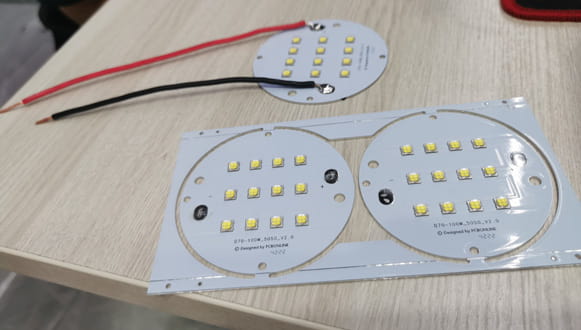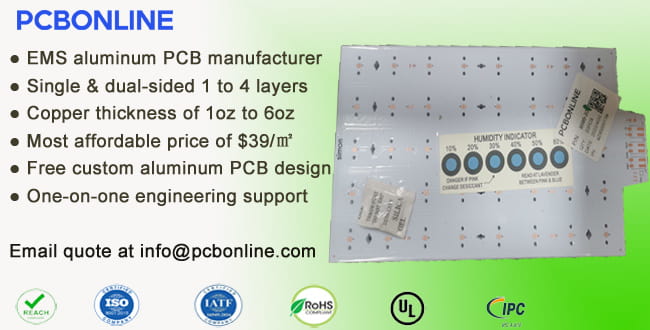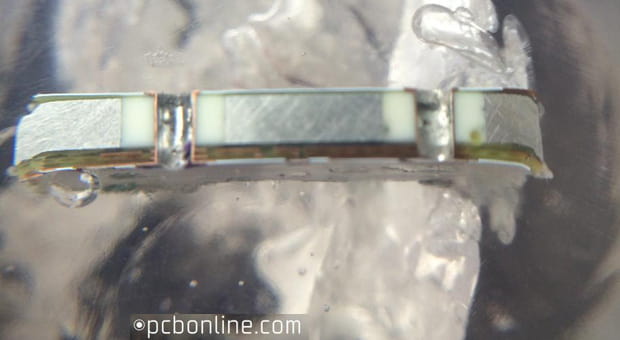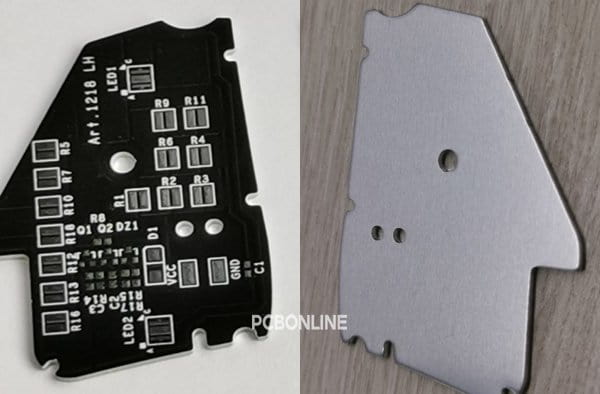Aluminum PCBs are the most common and cost-effective IMS circuit boards. For LED lights used for automotive, medical, industrial, public and home, and consumer electronics, aluminum PCBs are reliable carriers and mechanical supporters for LEDs and other components. And the design for aluminum PCBs is relatively easy. Besides, aluminum plates can be inlaid in FR4 PCBs to separate electrical and thermal networks for better thermal management.

Aluminum PCB fabrication is usually bulky quantity orders. Working with a reliable aluminum PCB manufacturer saves your fabrication costs and time.
PCBONLINE is a source factory manufacturer for one-stop aluminum PCBs based in Shenzhen, China. It has its aluminum PCB factory in Jiangxi, aluminum copper-clad laminates (CCL) factory, and PCB assembly factory for EMS production. It also has strategic cooperation with the aluminum CCL manufacturer Ventec. Automatic aluminum PCB manufacturing and cost-effective aluminum CCL lead to affordable aluminum PCB fabrication from PCBONLINE. For bulky aluminum PCB manufacturing, you only need to spend $39 per square meter, including design for manufacturing (DFM), PCB and STM stencil fabrication, and complete testing. The CAM and PCBA engineers with more than 20 years of experience provide one-on-one engineering support throughout your project.

How Does the Aluminum PCB Manufacturer Fabricate Aluminum PCBs?
Aluminum PCB fabrication doesn't allow hand touch, contamination, or scratches to the aluminum CCL, and qualified aluminum PCBs should have no burrs. From PCBONLINE, aluminum PCBs with single and dual component-mounting sides from 1 to 2 layers from prototypes to bulky manufacturing are available.
How does the aluminum PCB manufacturer finish PCB fabrication? Please check the aluminum PCB fabrication process below.
Step 1. Cut laminates
The CCL consists of the aluminum substrate, prepreg layer, and copper layer. But it is large, and the aluminum PCB manufacturer cuts the CCL to the required size.
Step 2. Drill positioning holes
Positioning holes are used as positioning reference points to drill PCB holes and fix the board during PCB fabrication and PCB assembly. The positioning holes are usually in the top left and bottom right corners of the aluminum PCB panel, and they are on the PCB edges, which are rid of when de-paneling the aluminum PCBs. And the aluminum PCB manufacturer designs them in the DFM process. After drilling positioning holes, the PCB manufacturer checks the hole edges and positions to make sure no burrs and offsets happen.
Step 3. Generate circuits
The aluminum PCB manufacturer uses a film and photoresist under UV light for exposure and development to transfer circuits on the copper layer of the aluminum CCL. For single component-mounting-sided aluminum PCBs, the circuits are directly generated by etching copper.
For dual component-mounting-sided aluminum PCBs with through-holes, it is a little complex. The aluminum PCB manufacturer PCBONLINE drills through holes larger than the designed PTH vias on the aluminum foil. Then it adds resin to the via walls with the required thickness to insulate the copper vias and the aluminum substrate and laminates the two prepreg layers on two sides of the aluminum foil. Later it laminates two copper layers on two sides to make the double-sided aluminum PCB and generates circuits.
You can check the cross-section of a double-sided aluminum PCB manufactured by PCBONLINE in the below image.

Step 4. Silkscreen print solder masks and silkscreens
The aluminum PCB manufacturer uses a film and solvent-based PCB ink under UV light to exposure, which makes the PCB ink on the solder mask areas cures. And then we bake the PCB to dry the PCB ink. For thick-copper aluminum PCBs (copper thickness from 30z to 6oz), the manufacturer PCBONLINE adopts the electrostatic spraying method to apply solder masks.
Then the manufacturer uses a film to print the silkscreens (marks and symbols to identify components, logos, and names on PCBs) on a stencil. And then PCB inks are printed on the aluminum PCB through the stencil and then baked.
Step 5. V-cut the aluminum PCB edges

The v-cut step is the last manufacturing step because we need to avoid possible burrs scratching the aluminum substrate and PCB surfaces. We use a punching machine to form shapes of the PCB panel. The V-cuts are the grooves on the aluminum PCBs for the manufacturer or its clients to depanelize aluminum PCBs.
Step 6. Automatic testing
Aluminum PCB testing has to be automatic because automatic testing elevates production efficiency and prevents any board from missing testing. It is crucial to quality control. The equipment we use for transferring aluminum PCBs is the automatic guided vehicle (AGV), which prevents scratches on the aluminum PCBs. We use a jig to conduct electrical testing and power-on self-testing. Later we have to complete the voltage withstand test to ensure the aluminum PCBs can work properly at the required voltages.
Step 7. Inspection confirmation and package
We conduct a full inspection and randomly pick up 10% of boards for sample inspection for confirmation. After inspection confirmation, we package the aluminum PCBs according to our client's requirements. Usually, the aluminum PCBs are sealed in vacuum bags with a humidity indicator and a desiccant, and the bags are placed in boxes with plastic sponges inside to separate and protect them.
Why do You Have Aluminum PCBs Manufactured by PCBONLINE?
From the aluminum PCB manufacturer PCBONLINE, you can have single and dual-sided aluminum PCBs from 1 to 2 layers manufactured from prototypes to bulk production. Our competitiveness is full automatic aluminum PCB fabrication, reliable CCL sources, and the lowest aluminum PCB price of only $39 per square meter.
Details of our competitiveness in aluminum PCB manufacturing are:

- Our aluminum PCB factory has 5 automatic punching lines and 5 AGVs, which increase 300% of production than half-automatic punching and prevent possible human harm.
- We have our aluminum CCl factory Yugu and keep strategic cooperation with the laminate manufacturer Ventec.
- Every manufacturing step has a group of workers responsible for sample inspection, which is dependent on the QC system and prevents defectiveness in advance.
- For your project, we can customize the thermal conductivity of aluminum PCBs from 1W/mK to 9W/mK.
- One-stop aluminum PCB LED light EMS manufacturing, including PCB design, PCB fabrication, component sourcing, PCB assembly, and box-build assembly.
Our CAM engineer provides one-on-one engineering support and can design aluminum and FR4/aluminum hybrid substrate LED PCBs for your project for free. If you feel interested in working with the aluminum PCB manufacturer PCBONLINE, please send your inquiry to info@pcbonline.com.
What Applications does the Aluminum PCB Manufacturer Work for?
From PCBONLINE, you can order aluminum PCBs from 1 to 2 layers at $39/㎡ for LED grow lights, automotive LED lights, floor lights, etc.
LED grow lights
LED grow lights or LED plant lights usually use aluminum PCBs. They can be supplementary light sources for both indoor and outdoor plant growth. The wavelength of the LED light should be appropriate for the plant intended to grow. PCBONLINE can custom design the wavelength, color temperature, and power of the aluminum light for your project.
Automotive LED lights
Automotive aluminum PCBs can be used for headlights and side front lights for cars, trucks, motors, etc. Automotive LEDs have high power and require good thermal dissipation of aluminum PCBs. The aluminum PCB manufacturer not only provides aluminum PCBs with custom thermal conductivity. It also conducts four-terminal sensing to ensure micro resistances of the circuits are qualified for the best reliability.
Floor lights and spotlights
Floor lights used for home and business and spotlights used in stages produce intense illumination. To make the light balanced without a halo, we intend to design chip-on-board (COB) LED lights. The aluminum PCB manufacturer PCBONLINE can design and fabricate COB LEDs with custom power by flip-chip or wire bonding.
Besides, you can have aluminum PCBs and ceramic PCBs manufactured by PCBONLINE for lights used on boats, in swimming pools, etc.
Conclusion
In this article, you learn about a one-stop aluminum PCB manufacturer PCBONLINE and how it manufactures aluminum PCBs. Working with a source manufacturer who conducts full automatic fabrication and has its CCL factory saves your fabrication costs and guarantees aluminum PCB quality to the best degree. And PCBONLINE is such a trustworthy and affordable aluminum PCB manufacturer. If you have any questions, welcome to chat with us online.
© This article is an original work of the PCBONLINE team. Please indicate the author PCBONLINE if you reprint. If the article is reproduced without permission or indicating the author's source, PCBONLINE reserves the right to investigate the infringement.




